Is Shakespeare Really the Author of Romeo and Juliet? Follow Ronan O’Connell – a journalist with 17 years of experience reporting on travel and current affairs for CNN, BBC…
The bustling noise of the Piazza Delle Erbe market fades behind me as I walk down Via Cappello in Verona towards a weathered stone archway adorned with love hearts. Beyond the gate, above a small courtyard, is the balcony where Juliet is said to have listened to Romeo sing.
Dozens of tourists have queued for their moment of “wherefore art thou, Romeo” beneath the balcony. Who should we ultimately thank for the world’s most famous love story?
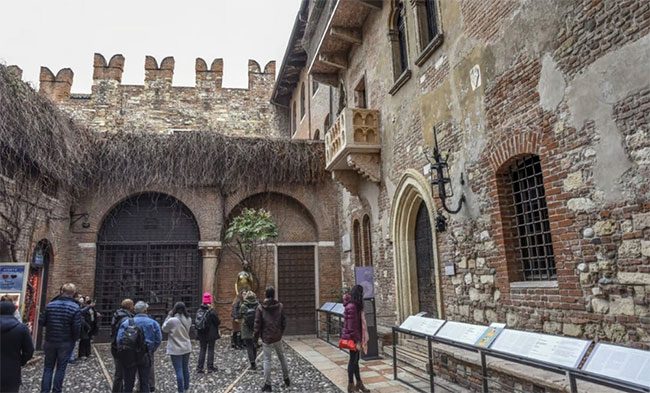
Tourists visiting a square in Verona, Italy, adjacent to Juliet’s famous house in the tragic love story of Romeo and Juliet by Shakespeare. However, he is believed not to have actually created the story – it was the work of an author from a nearby town. (Photo: Ronan O’Connell)
It is not William Shakespeare, although Romeo & Juliet helped the English writer gain fame during his lifetime and became a legend after his death. Thanks to its popular themes of love found and lost, the story has become a template for romantic tragedies, influencing countless plays, films, books, and television shows.
The popularity of the play is a significant draw for Verona, a picturesque city of 260,000 inhabitants in northeastern Italy. Established over 2,000 years ago, Verona is filled with historical monuments, including a large medieval fortress and a first-century amphitheater reminiscent of Rome’s Colosseum.
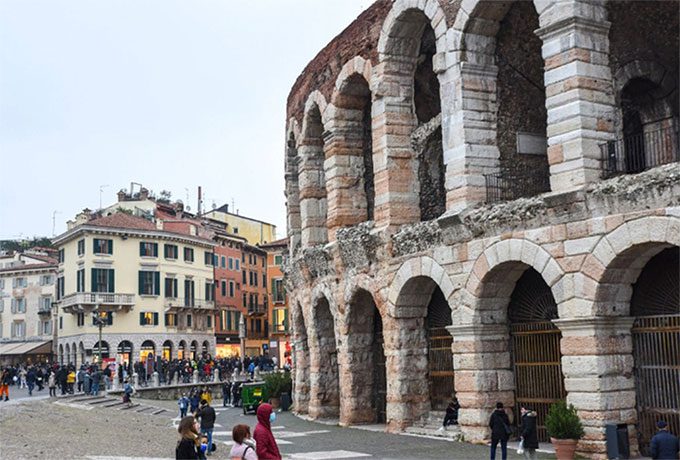
Verona Arena is a 2,000-year-old amphitheater. (Photo: Ronan O’Connell).
However, the city must still compete for attention with nearby Milan, Venice, and Florence, which helps explain why the city relies heavily on Romeo & Juliet as a marketing tool.
Guided walking tours in Verona include visits to Juliet’s tomb inside an old convent, which houses the Giovanni Battista Cavalcaselle Museum of Frescoes and the house believed to belong to her lover, the medieval Casa di Romeo.
Other highlights include a bust of Shakespeare in Piazza Bra, Verona’s largest square, an ancient plaque depicting Romeo on the façade of the 15th-century Palazzo Carlotti, and the Romeo e Giulietta Shop, one of many stores in the city selling clothing, candles, cups, artwork, and other souvenirs depicting the ill-fated lovers.
Not everyone in Verona agrees with using the story to attract tourists. Before the Covid-19 pandemic, Italian news outlets reported the residents’ anger at the crowds surrounding Juliet’s Balcony, which is attached to a 14th-century Gothic house known as Casa di Giulietta.
During peak summer, hundreds of tourists sometimes cram into the adjacent 400-square-meter (4,300-square-foot) space at once.
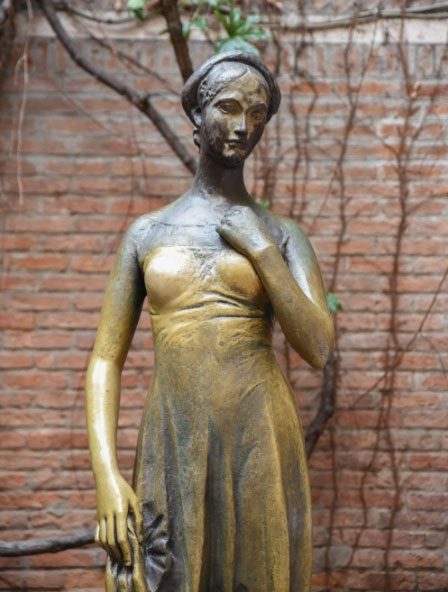
The bronze statue of Juliet in Verona, Italy. (Photo: Ronan O’Connell)
The sentiment became overwhelming to the point that authorities removed the bronze statue of Juliet from the square – the tradition of rubbing her bust for good luck risked causing irreparable damage.
Now, a replica replaces it, outside the Casa di Giulietta Museum opposite Juliet’s Balcony, which hosts a small exhibition of costumes and artworks related to Shakespeare’s famous plays.
While Romeo & Juliet may be celebrated as a work of Shakespeare, it was originally crafted by Luigi Da Porto, a soldier from Vicenza, a small town situated between Verona and Venice. In its original version, New Found Story of Two Noble Lovers, published in 1530, a few months after Da Porto’s death and nearly 70 years before Shakespeare adapted it.
Conversely, Da Porto is believed to have drawn on influential sources to create his tale. The soldier-turned-author was a product of the Renaissance in Europe from the 14th to the 17th century, a period marked by the rediscovery of classical art, literature, and philosophy, particularly from ancient Greece and Rome.

The city of Vicenza, viewed from the square in front of Santuario della Madonna di Monte Berico. (Photo: Italy)
Many Renaissance writers, including Shakespeare, produced plays and books based on classical stories. In fact, most of Shakespeare’s significant works borrowed heavily from other writers – although comically, his play The Two Gentlemen of Verona is not based on the work of an Italian writer but on the Spanish romantic story Los Siete Libros de la Diana by Portuguese author Jorge de Montemayor.
Da Porto borrowed as well. Some historians believe that his Newly Found Story of Two Noble Lovers was inspired by the second-century Greek love story of Anthia and Abrocomas.
The Italian tale centers on a pair of powerful and feuding Italian families, the Montecchis and Cappellettis (Shakespeare’s Montagues and Capulets).
One night, Romeus Montecchi and relatives crash a Cappelletti party, where he meets Giulietta. The young couple becomes infatuated with each other but Giulietta is soon to be married to the man chosen by her father. Therefore, Romeus and Giulietta secretly plot to marry, before he is drawn into a street fight, where one of Giulietta’s cousins dies. As a result, Romeus is exiled.
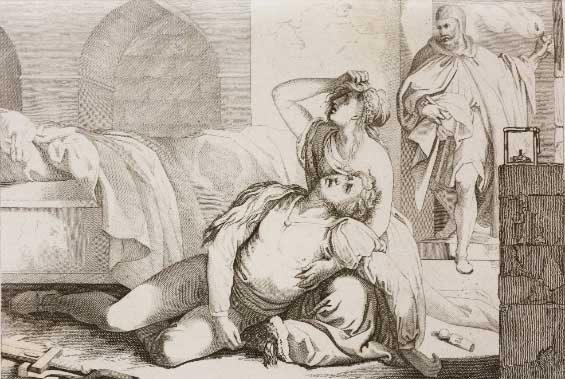
The deaths of Romeo and Juliet, from a painting by Pieraccini, in “Giulietta e Romeo” (Romeo and Juliet), the historical novel by Luigi da Porto. (Photo: Getty Images)
In a desperate attempt to save their love, Giulietta feigns death. Romeus finds her lifeless body, believing she is dead and commits suicide by drinking poison.
When Giulietta awakens, she discovers what Romeus has done but has time to speak to him before he dies (this does not happen in Shakespeare’s version). Heartbroken, Giulietta takes her own life by holding her breath.
While Da Porto’s poignant story continues – albeit rewritten – his remains rest in a magnificent setting. His tomb can be found within the Chiesa di Santa Corona, a 13th-century Romanesque church in Vicenza built to house a relic believed to be from the crown of thorns worn by Jesus during the crucifixion.
The three-story house where Da Porto lived and died still stands. Located at 15 Contra Porti Street and marked by a white stone plaque bearing his name, the building is just 200 meters north of the city’s main tourist attraction, the 16th-century Palladian basilica.
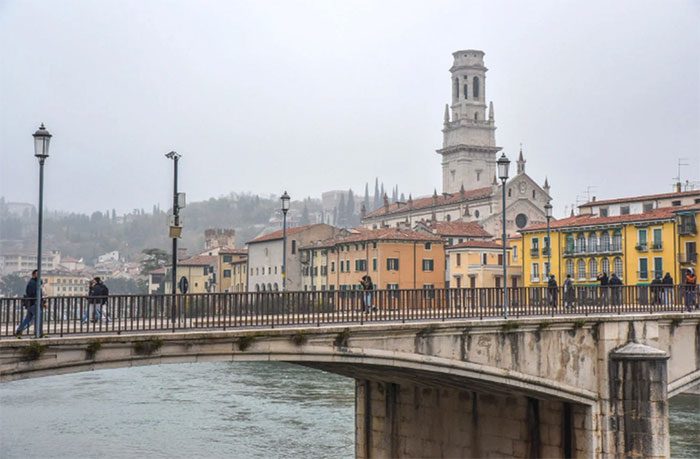
Verona hugs a bend in the Adige River, Italy. (Photo: Ronan O’Connell).
After a significant restoration a decade ago, the UNESCO-listed basilica reopened as a functioning center and museum (the current exhibition runs until May and features Egyptian artifacts).
Neither Da Porto’s tomb nor his old house is a major tourist attraction. Even in his hometown, he remains relatively obscure, in stark contrast to Shakespeare, who has become the subject of numerous books and essays about his life and works, and whose comedies and tragedies are taught in schools and universities around the world.
Born in Vicenza in 1485, Da Porto spent most of his formative years in the town. As an orphaned child, he received a good education thanks to a benevolent uncle. This information is provided based on one of the few detailed narratives of his life, in a 1868 text by Italian literature professor G. Pace-Sanfelice.
After his schooling, Da Porto joined the Venetian army, later being discharged due to serious injury in 1511. He returned to Vicenza and devoted himself to writing.
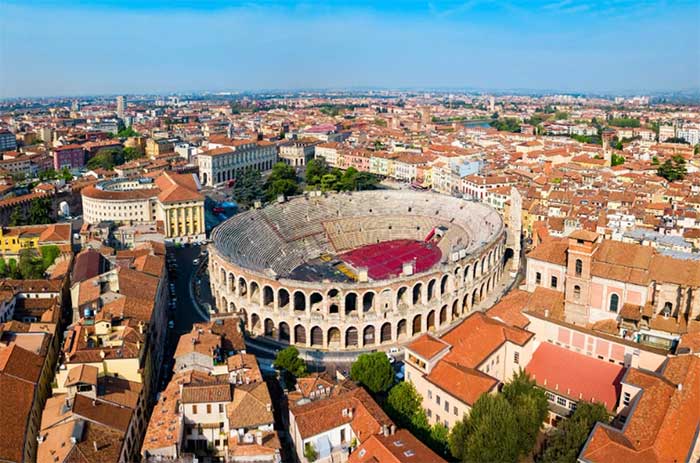
Verona Arena is a Roman amphitheater in Piazza Bra. (Photo: Getty Images)
By the time Da Porto died from a virus in 1529 at the age of 43, he had written over 70 poems and a novel of his, Newly Found Story of Two Noble Lovers, was published the following year.
Some historians believe that at least part of the tragic story of Da Porto was informed by his own heart-wrenching romantic experiences. Others think that real events that took place in Verona, located 40 km west of Vicenza, helped inspire the tale. They argue that the families of Cappelletti and Montecchi actually existed.
The balcony of Juliet, located just 200 meters south of Casa di Romeo, would not be pinned on the tourist map of Verona if it weren’t for Da Porto.
He was not, and will never be, revered like Shakespeare, but this overlooked Italian writer remains the author of the most influential love story in history.




















































